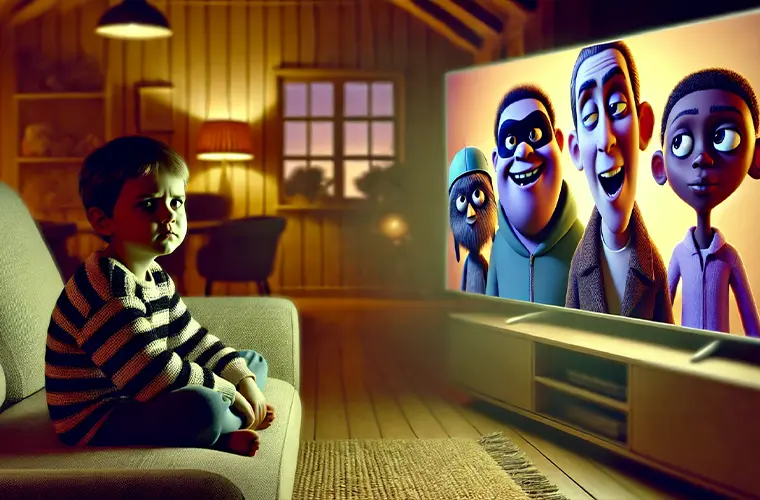In animated films beloved by children worldwide, there’s a subtle but powerful message hiding in plain sight: characters with crossed or drifting eyes—known as strabismus—are more likely to be depicted as villains, sidekicks, or bumbling fools.
According to a recent study from the University of Colorado School of Medicine, this portrayal could contribute to implicit bias and the stigma that children with this common eye condition already face in real life.
“When animators are figuring out what a character is going to look like, they have to decide on every little detail of that character’s appearance, and so it’s not by chance that an animated character happens to have strabismus,” Dr. Michael Puente, an assistant professor of ophthalmology at Colorado and study co-author, said in a statement. “That’s something that the animation team made a deliberate decision to do, and I imagine that they have reasons for that decision.”
“Our study suggests that commonly, the reason that a character is depicted as having strabismus is if that character is unintelligent or undesirable, and that animators see strabismus as a way of visually conveying that undesirable trait.”
In a comprehensive analysis published in Pediatrics, researchers examined 125 animated films produced by major studios, including Disney, Pixar, DreamWorks, and Studio Ghibli, between 1989 and 2022.
Their findings are striking: Of the 46 characters identified with strabismus, overwhelmingly assigned secondary or peripheral roles, they were frequently presented as unintelligent, clumsy, or villainous. Researchers say the implications of these portrayals go beyond the screen, potentially impacting how young viewers perceive and react to real people with strabismus.
According to study authors, adding a physical difference like strabismus to a character can instantly signal something about that character’s role or personality. Unfortunately, that difference often signifies a lack of intelligence or moral corruption.
The study reveals how visual storytelling often relies on shorthand traits to convey personalities or motives quickly. For example, the popular character Ed the hyena from Disney’s The Lion King is the only character with strabismus in the film. Ed, who doesn’t speak, communicates through manic laughter, chews on his limbs, and is derided by the film’s villain as “vacant” or unintelligent.
Likewise, in Moana, the character Heihei the chicken is portrayed with exaggerated, drifting eyes and is intended as comic relief, often stumbling and appearing clueless. According to one of the film’s directors, Heihei was designed to be “the stupidest character in the history of Disney animation.”
The study’s character traits associated with strabismus include a disturbing pattern: 30% of characters were considered unintelligent, 24% were frightening, and 35% had additional physical deformities, such as missing teeth or a hunched back.
Such depictions were typically applied to background or secondary characters. Only two characters with strabismus were central to their storylines, and both were villains, reinforcing a pattern that villainy and physical “otherness” are often coupled.
Characters in children’s films often function as role models or representatives of particular social traits, which young minds quickly absorb.
The study’s authors explain that children exposed to these representations may unconsciously associate strabismus with negative qualities. “Media such as television and film have the potential to influence the developing worldview of children with young impressionable minds,” researchers wrote. The study emphasizes that repeated exposure to these characters risks reinforcing harmful stereotypes and might even shape young viewers’ real-world attitudes toward children or adults with strabismus.
According to researchers, young viewers don’t necessarily see these characters as representations of a medical condition—they see that characters with misaligned eyes are bad or bumbling. Unfortunately, this association can translate into real biases. The research sheds light on how deeply ingrained these depictions are across the industry, suggesting a broader responsibility for animation studios.
Strabismus, which affects about 2-4% of children, often goes beyond a simple misalignment of the eyes. For many, it can contribute to challenges with social integration, affecting confidence, self-esteem, and even academic success. Studies have shown that children with strabismus are more likely to face isolation, exclusion, and lower acceptance rates among their peers. For example, children aged 8 to 12 are less likely to sit next to a peer with strabismus and are less willing to invite them to social gatherings.
The medical implications of these portrayals are significant. Pediatricians and ophthalmologists argue that seeing negative or distorted portrayals of strabismus can impact children with the condition, possibly affecting their self-image and leading to feelings of inadequacy.
“Every day I have kids that are asking me for surgery, and that says a lot as children tend to be apprehensive of medical care,” Dr. Puente said. “But strabismus often affects these kids so much that they’re asking for a fix. I don’t think there are a lot of other pediatric surgeons that have that experience.”
“Kids with strabismus, unfortunately, get bullied a lot for that difference in appearance,” Dr. Puente added. “There have been studies that find that they’re less likely to get invited to birthday parties. Kids in school are less willing to sit next to a kid with strabismus. There have been surveys of teachers that have found that teachers tend to assume that students with strabismus are less intelligent, and all this stigma affects the way that children develop psychosocially.”
The study’s authors argue that animation studios have an opportunity—and a responsibility—to rethink these portrayals. The American Academy of Pediatrics, which also addresses the impact of media on children’s social development, encourages the industry to minimize negative stereotypes and promote positive depictions of differences.
The researchers suggest that studios take this opportunity to diversify their portrayals, creating more positive representations of characters with conditions like strabismus.
Films such as The Good Dinosaur offer a glimmer of hope. In this Pixar film, the character Forrest Woodbush has strabismus, but he’s portrayed as wise, brave, and kind, setting a positive example. Yet, according to the researchers, out of the 125 films reviewed, this was the only instance of a character with strabismus being portrayed as intelligent.
The research provides a critical perspective on how something as simple as character design in children’s media can have far-reaching effects on real children’s lives.
As animation studios continue to create beloved characters, the hope is that these companies will take the findings seriously, fostering a shift toward inclusivity and compassion.
As society becomes increasingly aware of the media’s role in shaping social perceptions, studios are under pressure to be mindful of the subtle messages they are sending. In this era of media influence, a single character with crossed eyes can become either a symbol of stigma or a positive representation that children with strabismus can look up to.
“If animators recognize that they tend to always portray strabismus so negatively, I hope they can reflect on that, and maybe when they have an undesirable character or a bad guy or a ‘dumb’ character, they think twice before giving it strabismus,” Dr. Puente said. “It sends a message to their very young, impressionable audience.”
“There are lots of people with strabismus, and it would be great to have some characters with strabismus that could be role models and are portrayed positively. That just doesn’t exist in any of these movies in our study, but I think that would be a really impactful change.”
Tim McMillan is a retired law enforcement executive, investigative reporter and co-founder of The Debrief. His writing typically focuses on defense, national security, the Intelligence Community and topics related to psychology. You can follow Tim on Twitter: @LtTimMcMillan. Tim can be reached by email: tim@thedebrief.org or through encrypted email: LtTimMcMillan@protonmail.com

